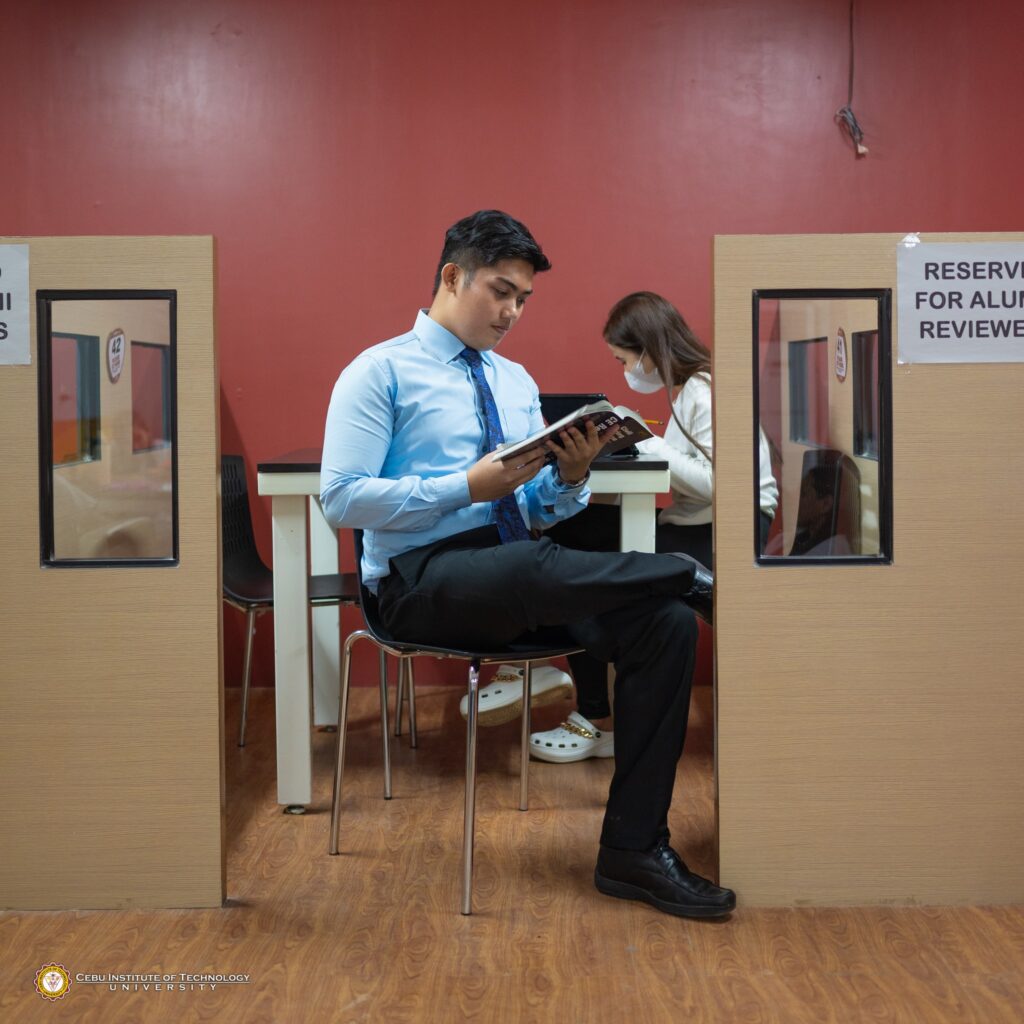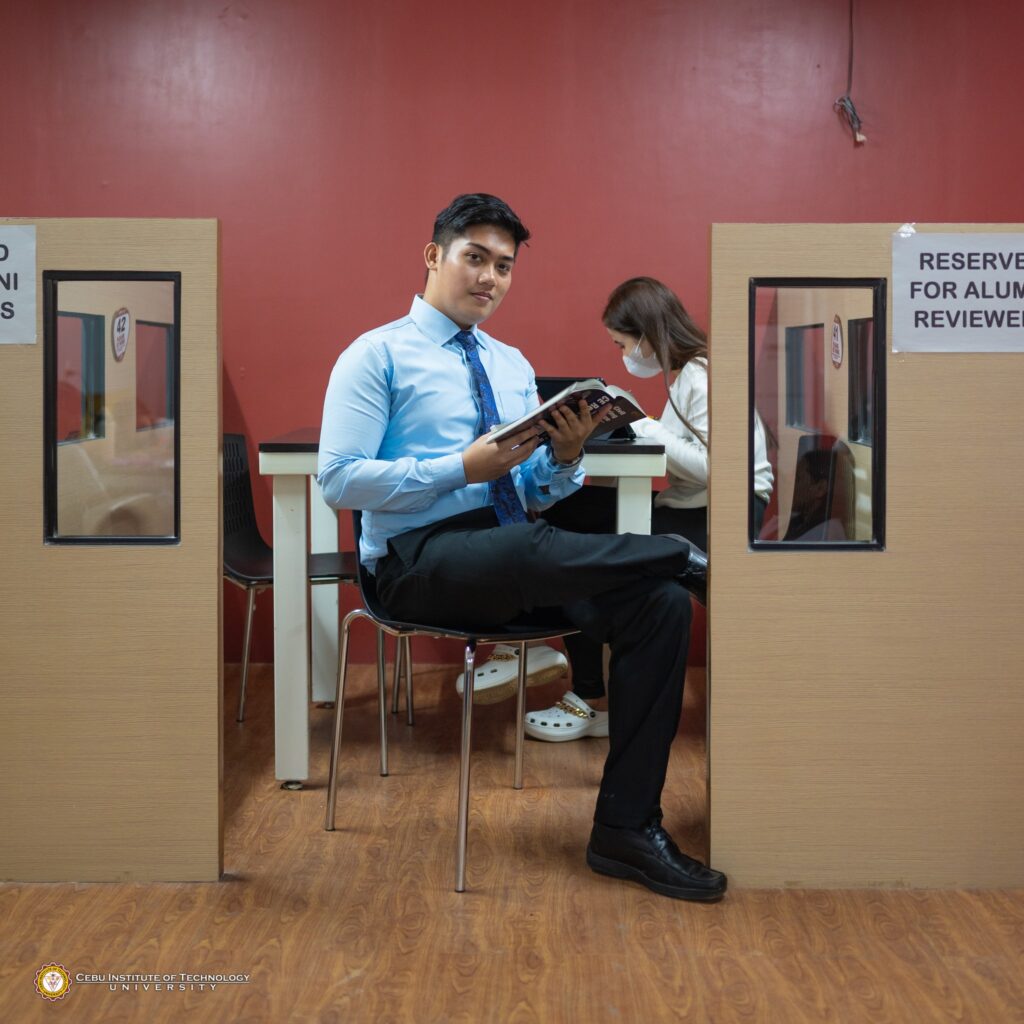
When it comes to excelling in the competitive world of education, especially in a top Philippine University like CIT University in Cebu, where engineering, IT, science, and technology education are highly esteemed, one can’t underestimate the power of effective study habits. If you’re a student aspiring to reach the pinnacle of academic achievement, we’ve got just the insights you need.
In this blog, we delve into the study habits that propelled our very own FIRST PLACER of the August 2023 Mechanical Engineer Licensure Exam, Engr. Roy Christian P. Oro, to success.
Whether you’re a student at CIT University or any college in Cebu, the strategies shared here are universal and can help you ace your exams and emerge victorious in your academic journey.
In his own words, and based on personal experience, Engr. Oro shared his journey to the top.
Get your notes ready because we start in 3, 2, 1!

- Study in an environment conducive to learning.
As much as I’d like to study in the confines of my comfortable room, I always found it difficult to be productive at home. I always saw my room as a sanctuary, somewhere I could do whatever I wanted and unwind from all the stress in life. As such, I could never concentrate on my studies. One moment I was solving a problem in Math, the next I would be lying on my bed taking a nap. Sometimes, I would rather be playing video games. Hence, I made the decision to study in the library as much as I could. Surrounded by people who are also poring over their books and notes, I would feel the “peer pressure” to focus and study. In the library, I was in the presence of less distractions, and I could concentrate on studying. Let me also hasten to add that this may depend on the person studying. I understand that there are others who find it easier to focus studying when at home than in a library where they are easily distracted by talking with their peers. So whichever works to your advantage, if you find it conducive to your learning, study there.
- Turn studying into a routine.
Instead of studying whenever I had time, I created a study schedule that I strictly followed. My study routine entails recalling the sets of formula on the wall after waking up, studying at the library every afternoon from 1:00 PM – 5:00 PM, and studying at home after our evening classes until 12 AM. Initially, I could not follow my routine because I would procrastinate. After some time, however, it became a habit. Once I established my routine, it became easy to get into the “zone”. I no longer had to convince myself to study and I was not easily distracted during my studies. Starting a new habit will be a challenge, but your labor will not be in vain.

- Create breathing spaces in between study periods.
Studying can burn you out. I experienced that, too. Because of this, I incorporated short breaks within my study sessions so I could avoid burnouts and distractions. I remember an instance when I did not take a break after solving many engineering problems. I just felt like my head was about to explode. So, I made a change. I took a minute to get up from my seat and stretch after a while. However, I do not recommend playing one game of ML or watching one video on YouTube during these breaks as it will snowball into an inescapable loop of one more game or video. In addition, what really worked for me aside from doing some stretching was having a quick snack or drink. To make these breaks happen, I use the Pomodoro technique via a mobile application when creating breathing spaces in my study schedule. This technique enabled me to allot 25 minutes of studying followed by a 5-minute short break. This cycle is repeated 4 times after which, I would allow myself a longer break of 15–20 minutes.
- Use flashcards to sharpen memory.
Yes, elementary-style flashcards still work for me! Using flashcards is a fantastic way to not only memorize terms and sets of formulas but also to test one’s proficiency. Almost all the terms I studied for the licensure exam were in the form of flashcards. With online flashcards via my phone, I study them whenever I have time, such as during commute and before going to sleep. I prefer flashcards rather than notes because I have already memorized the chronological flow of that which I need to memorize. With flashcards however, these items are shuffled randomly so I would have the certainty that I remembered the items correctly.
- Use memorization techniques.
Do you ever want to commit various formulas and concepts to memory and find this a herculean task especially when it covers many topics? I know how that feels. In some cases, there are just too many things to memorize and too little space available in our memory. That is why I only memorize empirical formulas and dates while using memorization techniques so that I can recall the others. Here are some memorization techniques I use:
- Understand the Derivation
Most of the time, the formulas are easy to derive based on a rule/law. Instead of memorizing the entire formula, I try to understand how it was derived. Even though it is a longer process, I find it easier to recall because I just need to recall the first step, and everything just follows. For example, the formula for the volume of the spherical wedge is just based on the formula for the volume of the sphere multiplied by the ratio between its angle and 360 degrees which is the central angle for a sphere. 😉
- Link it
Another technique that worked for me was linking new knowledge to something I already know no matter how farfetched. For example, the formula for the Energy Efficiency Ratio (EER) is 3.412 times the Coefficient of Performance (COP). The easiest way for me to remember 3.412 is to link to the value of pi (3.142) but the first 2 numbers are switched.
- Memorable visual images
I also find that using images makes it easier for me to recall difficult concepts. The image must be related to the concept so that it is easier to imagine. It does not even have to be something visual. It could be related to the sense of hearing, touch or feeling. For example, the formula for the speed of sound in gas is the square root of kRT. If you write that down, it looks like the word “skrt”. So, I connected that formula to an image of a rapper doing the “skrt” sound to make it easier to recall. See that, too? I told you. 😅
- Create a story/code
When memorizing a list, you could try to create a mnemonic for it. For example, the mnemonic All Students Take Chemistry is a way to memorize which trigonometric function is positive in each quadrant (I = All, II = Sine, III = Tangent, IV = Cosine). Another way to memorize a formula is to create a story that is related to the variables in it. For example, the formula for the area of a triangle inscribed in a circle = abc/4r. The story I relate to this one is “Ang Buong Circle hinati sa apat na rehiyon”. If you draw the figure, the circle is truly partitioned into 4 regions.

Now that you have an insider’s perspective on these study habits, you can apply them to your academic journey, whether you’re a student at CIT University or any other university in Cebu. Success is within your grasp; all you need to do is unlock your potential through effective study habits.
